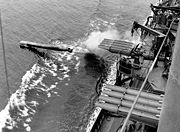
Mark 15 torpedo
Encyclopedia

Destroyer
In naval terminology, a destroyer is a fast and maneuverable yet long-endurance warship intended to escort larger vessels in a fleet, convoy or battle group and defend them against smaller, powerful, short-range attackers. Destroyers, originally called torpedo-boat destroyers in 1892, evolved from...
-launched torpedo
Torpedo
The modern torpedo is a self-propelled missile weapon with an explosive warhead, launched above or below the water surface, propelled underwater towards a target, and designed to detonate either on contact with it or in proximity to it.The term torpedo was originally employed for...
of World War II
World War II
World War II, or the Second World War , was a global conflict lasting from 1939 to 1945, involving most of the world's nations—including all of the great powers—eventually forming two opposing military alliances: the Allies and the Axis...
, the Mark 15 was very similar in design to the Mark 14 torpedo
Mark 14 torpedo
The Mark 14 torpedo was the United States Navy's standard submarine-launched anti-ship torpedo of World War II.This weapon was plagued with many problems which crippled its performance early in the war, and was supplemented by the Mark 18 electric torpedo in the last 2 years of the war...
except that it was longer, lighter, and had longer range and larger warhead. 9,700 were produced during the war.
The Mark 15 suffered from the same basic design problems that plagued the Mark 14 for the first 20 months following U.S. entry into the war, though this was not realized nearly as quickly by the destroyer crews as it was by the submariners. Surface-combatant torpedo attacks very often included confusing splashes from gunnery and aerial bombs, obscuring smoke screens, and quick maneuvering to evade counterattack. Rarely was a destroyer given a chance for a slow, careful surprise attack. Torpedo results were difficult to estimate under these circumstances. The correction of the Mark 15's problems would depend on the submariners solving theirs.
The Battle of Vella Gulf
Battle of Vella Gulf
The was a naval battle of the Pacific campaign of World War II fought on the night of 6-7 August 1943, in Vella Gulf between Vella Lavella Island and Kolombangara Island in the Solomon Islands of the Southwest Pacific....
on the night of August 6, 1943 – August 7, 1943, was the first in which a surprise torpedo attack by U.S. gave the Americans an overwhelming advantage in the following gun battle, though one Japanese warship was hit by a dud torpedo and escaped. By September, 1943, effective methods of torpedo deployment were beginning to be distributed to all U.S. destroyers.
Tactics
Anticipating the possibility of war with Japan, the United States planned to move their battleships across the Pacific with the fleet train. Cruisers and destroyers would be responsible for defending this large formation at night. Fleet exercises held during the 1930s revealed the confusing nature of close range engagements during hours of darkness. In 1932, during Fleet Problem XIII, "attacking" destroyers closed to within 500 yd (457 m) of USS SaratogaUSS Saratoga (CV-3)
USS Saratoga was the second aircraft carrier of the United States Navy and the fifth ship to bear her name. She was commissioned one month earlier than her sister and class leader, , which is the third actually commissioned after and Saratoga...
before being detected. Fleet Problem XV in 1934 placed the destroyer screen 7 nmi (13 km; 8.1 mi) beyond the battleship formation, but the battleships were unable to differentiate "friend" from "foe" at that distance. Screening destroyers were subsequently stationed at effective searchlight illumination range, 3 nmi (5.6 km; 3.5 mi). Recognition improved at that distance, but torpedo hit probability increased as evasive maneuvering of the large, compact force was restricted within the closer screen.
United States Navy War Instructions (FTP 143) published in 1934 remained in effect through the initial 1942 engagements in the Solomon Islands. The instructions emphasized defense to avoid the attrition objective of Japanese planning:
- Cruisers were advised to avoid night action unless conditions were favorable.
- Destroyers were to attack at once with guns, but reserve torpedoes for use against capital ships.
Searchlight illumination range effectively covered launch positions of United States torpedoes, but not the Japanese Type 93 torpedo
Type 93 torpedo
The Type 93 was a -diameter torpedo of the Imperial Japanese Navy , launched from surface ships. It is commonly referred to as the Long Lance by most modern English-language naval historians, a nickname given it after the war by Samuel E. Morison, the chief historian of the U.S...
. Japanese ships could remain outside of illumination range, launching torpedoes at American ships revealing their position with gunfire and searchlights.
Characteristics
- Function: Anti-ship
- Powerplant: Wet-heater combustion / steam turbineSteam turbineA steam turbine is a mechanical device that extracts thermal energy from pressurized steam, and converts it into rotary motion. Its modern manifestation was invented by Sir Charles Parsons in 1884....
with compressed air tank - Fuel: MethanolMethanolMethanol, also known as methyl alcohol, wood alcohol, wood naphtha or wood spirits, is a chemical with the formula CH3OH . It is the simplest alcohol, and is a light, volatile, colorless, flammable liquid with a distinctive odor very similar to, but slightly sweeter than, ethanol...
- Length: 24 ft (7.32 m)
- Weight: 2,840 lb (1288 kg)
- Diameter: 21 in (53 cm)
- Range / Speed:
- Low speed: 15,000 yards at 26.5 knots (13,500 meters at 49 km/h)
- High speed: 6,000 yards at 45 knots (5,500 meters at 83 km/h)
- Guidance system: Gyroscope
- Warhead: 825 lb (375 kg) of TorpexTorpexTorpex is a secondary explosive 50% more powerful than TNT by mass. Torpex is composed of 42% RDX, 40% TNT and 18% powdered aluminium. It was used in the Second World War from late 1942. The name is short for Torpedo Explosive', having been originally developed for use in torpedoes...
- Date deployed:
- Date withdrawn:

